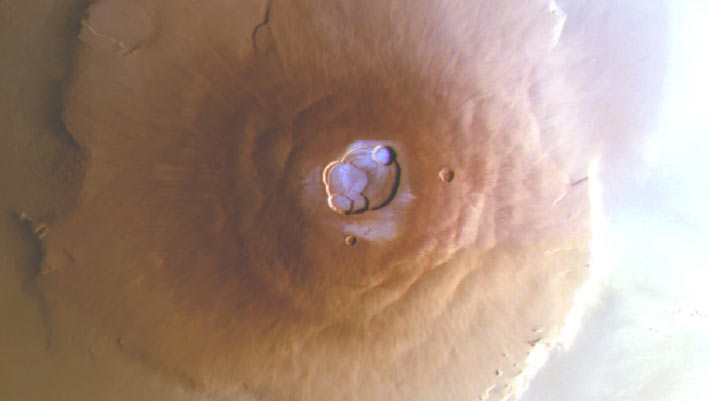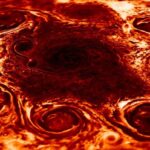Using high-resolution color images from ESA’s Trace Gas Orbiter (TGO) and Mars Express missions, planetary researchers have found evidence for morning frost deposits on the calderas of the Tharsis volcanoes on Mars: Olympus, Arsia and Ascraeus Montes, and Ceraunius Tholus.
This image, obtained by the High Resolution Stereo Camera aboard ESA’s Mars Express spacecraft, shows Olympus Mons, the tallest volcano not only on Mars but in the entire Solar System. Image credit: ESA / DLR / FU Berlin.
The Tharsis region of Mars hosts numerous volcanoes, including Olympus Mons and the Tharsis Montes: Ascraeus, Pavonis and Arsia Mons.
Many of these volcanoes are colossal, towering above the surrounding plains at heights ranging from one (Pavonis Mons) to three (Olympus Mons) times that of Earth’s Mount Everest.
These volcanoes have calderas, large hollows, at their summits, caused as magma chambers emptied during past eruptions.
“We thought it was impossible for frost to form around Mars’ equator, as the mix of sunshine and thin atmosphere keeps temperatures relatively high at both surface and mountaintop — unlike what we see on Earth, where you might expect to see frosty peaks,” said Dr. Adomas Valantinas, a postdoctoral researcher at Brown University.
“Its existence here is exciting, and hints that there are exceptional processes at play that are allowing frost to form.”
The patches of frost are present for a few hours around sunrise before they evaporate in sunlight.
Despite being thin — likely only one-hundredth of a millimeter thick (as thick as a human hair) — they cover a vast area.
The amount of frost represents about 150,000 tons of water swapping between surface and atmosphere each day during the cold seasons, the equivalent of roughly 60 Olympic swimming pools.
The researchers propose that air circulates in a peculiar way above Tharsis; this creates a unique microclimate within the calderas of the volcanoes there that allows patches of frost to form.
“Winds travel up the slopes of the mountains, bringing relatively moist air from near the surface up to higher altitudes, where it condenses and settles as frost,” said University of Bern’s Dr. Nicolas Thomas, principal investigator of TGO’s Colour and Stereo Surface Imaging System (CaSSIS).
“We actually see this happening on Earth and other parts of Mars, with the same phenomenon causing the seasonal Martian Arsia Mons Elongated Cloud.”
“The frost we see atop Mars’ volcanoes appears to settle in the shadowed regions of the calderas especially, where temperatures are colder.”
The scientists spotted frosts on the Tharsis volcanoes of Olympus, Arsia and Ascraeus Mons, and Ceraunius Tholus.
Modeling how these frosts form could allow scientists to reveal more of Mars’ remaining secrets, including where water exists and how it moves between reservoirs, and understanding the planet’s complex atmospheric dynamics.
Such knowledge is essential for our future exploration of Mars, and our search for possible signs of life beyond Earth.
“Finding water on the surface of Mars is always exciting, both for scientific interest and for its implications for human and robotic exploration,” said Dr. Colin Wilson, ESA project scientist for both ExoMars TGO and Mars Express.
“Even so, this discovery is particularly fascinating. Mars’ low atmospheric pressure creates an unfamiliar situation where the planet’s mountaintops aren’t usually colder than its plains — but it seems that moist air blowing up mountain slopes can still condense into frost, a decidedly Earth-like phenomenon.”
“This discovery was possible thanks to successful collaboration between both of ESA’s Mars orbiters, and additional modeling.”
“Understanding exactly which phenomena are the same or different on Earth and Mars really tests and improves our understanding of basic processes happening on not only our home planet, but elsewhere in the cosmos.”
The findings were published in the journal Nature Geoscience.
_____
A. Valantinas et al. Evidence for transient morning water frost deposits on the Tharsis volcanoes of Mars. Nat. Geosci, published online June 10, 2024; doi: 10.1038/s41561-024-01457-7




